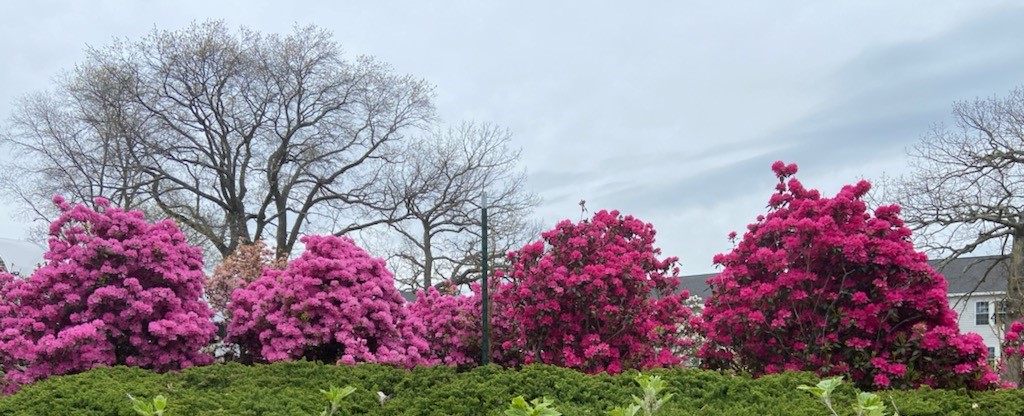
By Wayne Mezitt
For many of us, the name “azalea” conjures up visions of a bountiful spring garden in all its glory. Few landscape shrubs are so versatile. Botanically all azaleas are rhododendrons, but their features differ enough so we all call them azaleas. And understanding their features helps determine how to use them most effectively. Here’s a brief summary of the types of azaleas suitable for this region.
Evergreen azaleas retain leaves over the winter. Many evergreen types perform acceptably well in southern New England gardens (USDA Zones 5 and warmer), but don’t expect the luxurious profusion of color we so admire in southern landscapes—our winters are simply too challenging—I actually consider them “semi-evergreen” in this climate. Most evergreen species and cultivars bloom for about two weeks around Mother’s Day, sometimes into early June. Their colors range from white to pink to purple, but none (yet) have yellow flowers. They are relatively slow and wide-growing, reaching about 3 ft. at ten years of age, and the dwarf/compact types are slower. Evergreen types do well in part shade, under a canopy of trees, and prefer a measure of protection from drying winter winds. After severe winters with little snow cover, flower buds and foliage can be affected, resulting in discolored leaves, reduced bloom and branch dieback.
Deciduous azaleas drop their leaves in dormant seasons. All shrubs in the deciduous group tend to be significantly more winter hardy than evergreen types, growing well in USDA Zones 6, 5 and 4, and some even adaptable to Zone 3. All the azaleas that are native to the USA are deciduous. The deciduous species and cultivars grow faster and taller than the evergreens, reaching about 5 ft. high and 3 ft. wide in 10 years, although some grow more slowly. With a wide range of flower colors, some have fragrance, and they generally feature larger flowers than the evergreen types that are reliable in this climate.
Both royal (R. schlippenbachii) and pinkshell (R. vaseyi) azaleas are deciduous and bloom in late April for a splash of early color. Most other deciduous types bloom from mid-late May into early June. But the deciduous “Summer Azaleas” have native parentage of sweet (R. arborescens), Cumberland (R. bakeri), flame (R. calendulaceum), plumleaf (R. prunifolium) or swamp (R. viscosum) azaleas, and they open their flowers from mid-June into July. All the deciduous azaleas display flower color for about a two-week period, depending upon conditions. Because they virtually “disappear” from view when they drop their leaves in autumn, try using them against a background of conifers or broadleaf evergreens.
Both evergreen and deciduous azaleas enjoy rich, acid, humusy soils with good drainage. It’s a good idea to mulch around their roots and prune branches only when (or if) they become unruly, and always just after they bloom. Ask the experts at your local garden center for more information about availability and suitability recommendations for your garden locations.
As practical consideration in this region, you might consider planting one of the so-called Early Rhododendrons (like PJM, Olga Mezitt, Landmark) as an alternative. Yes, they bloom a week or two earlier than typical evergreen azaleas, but they’re reliable every year even in Zone 5, retain their foliage over the winter, tend to mature smaller than large-leaf rhododendrons and grow well even in full sun.









